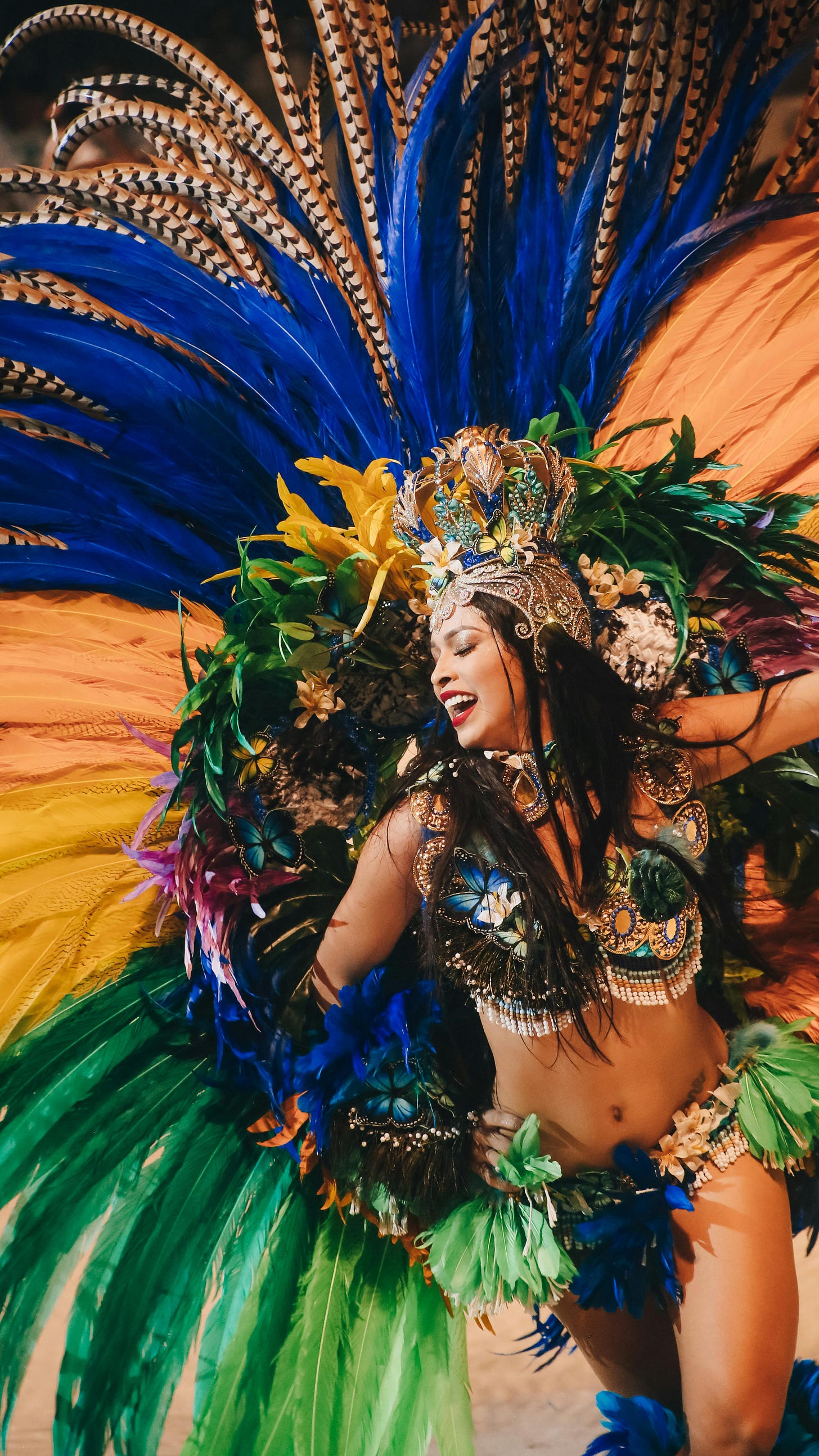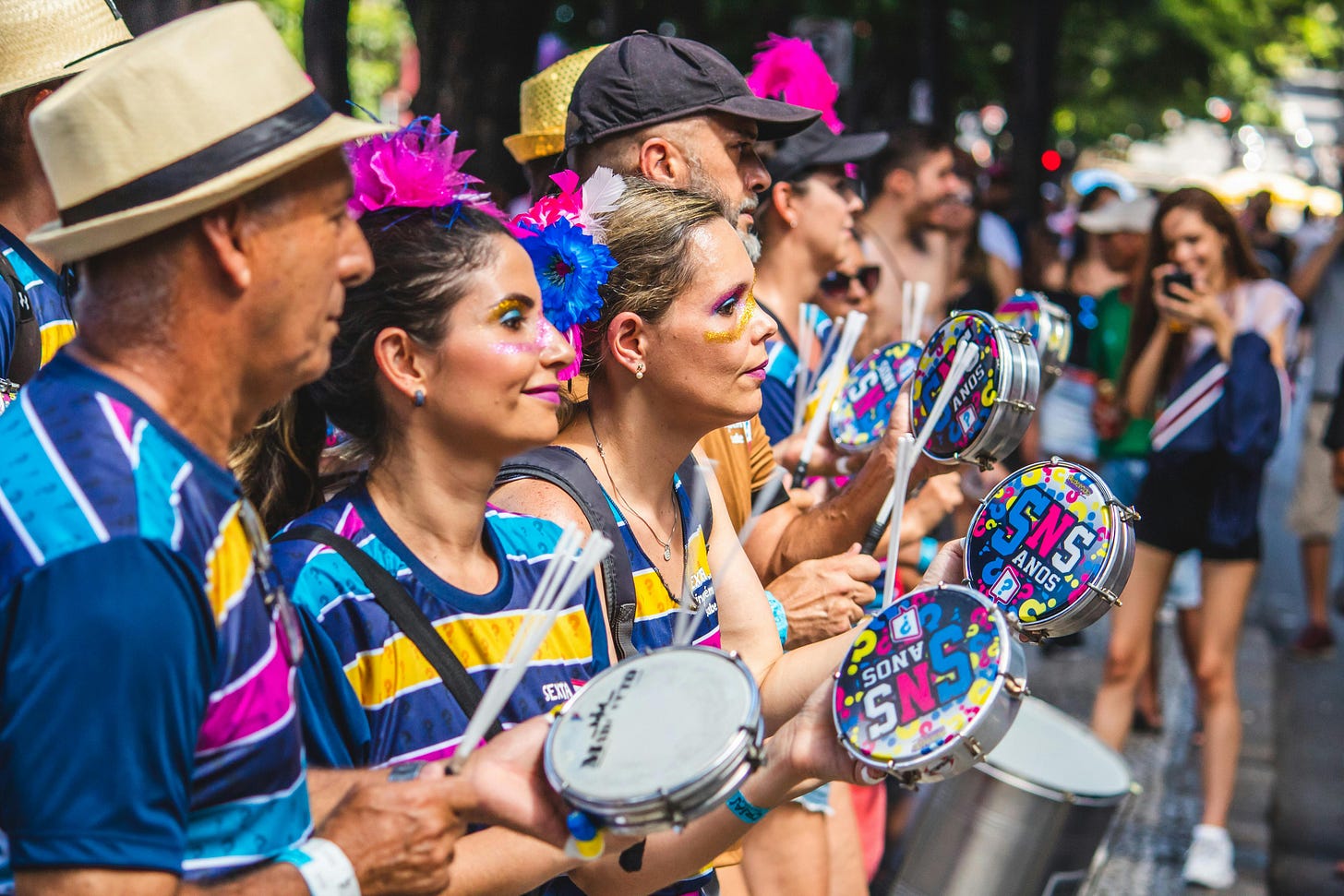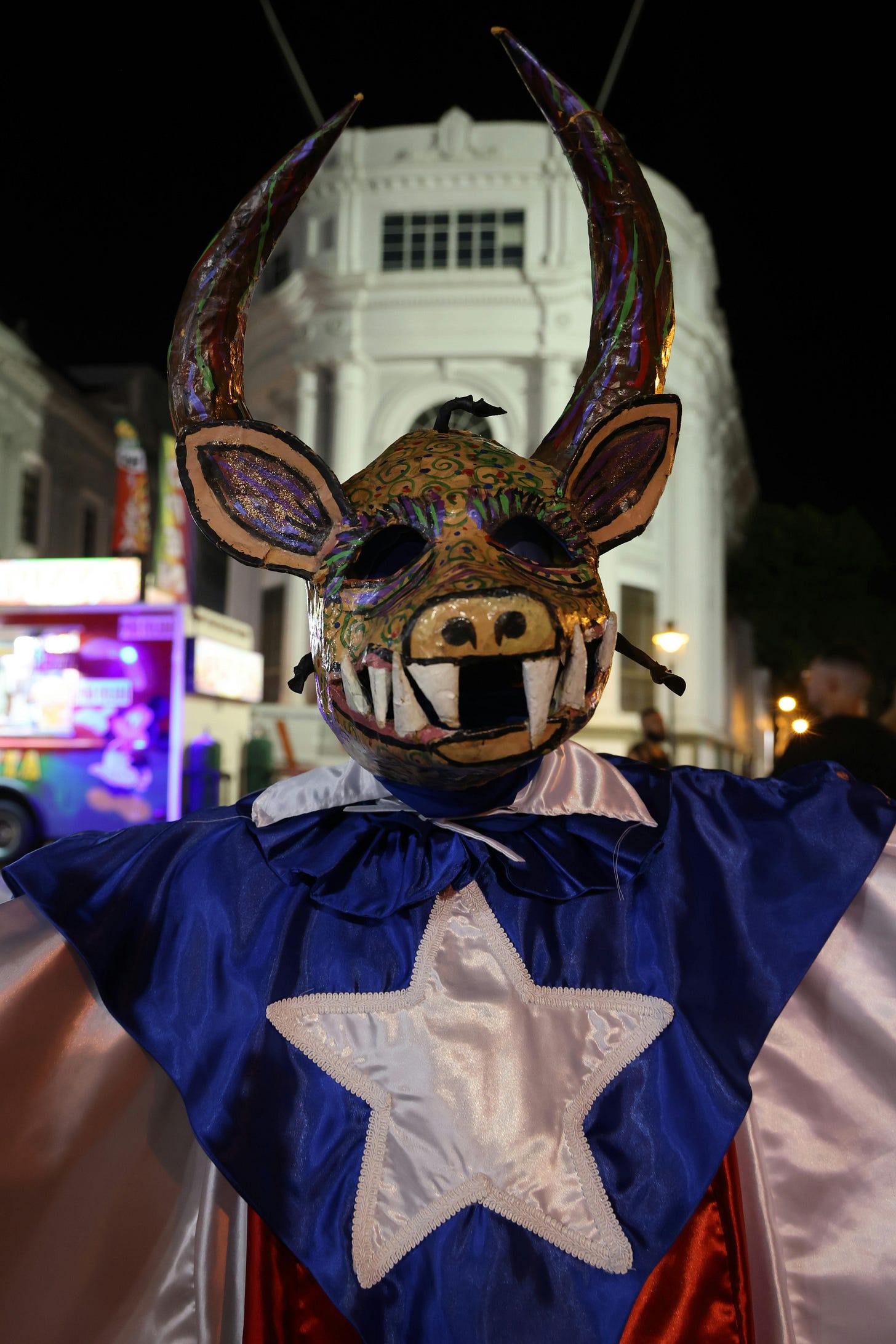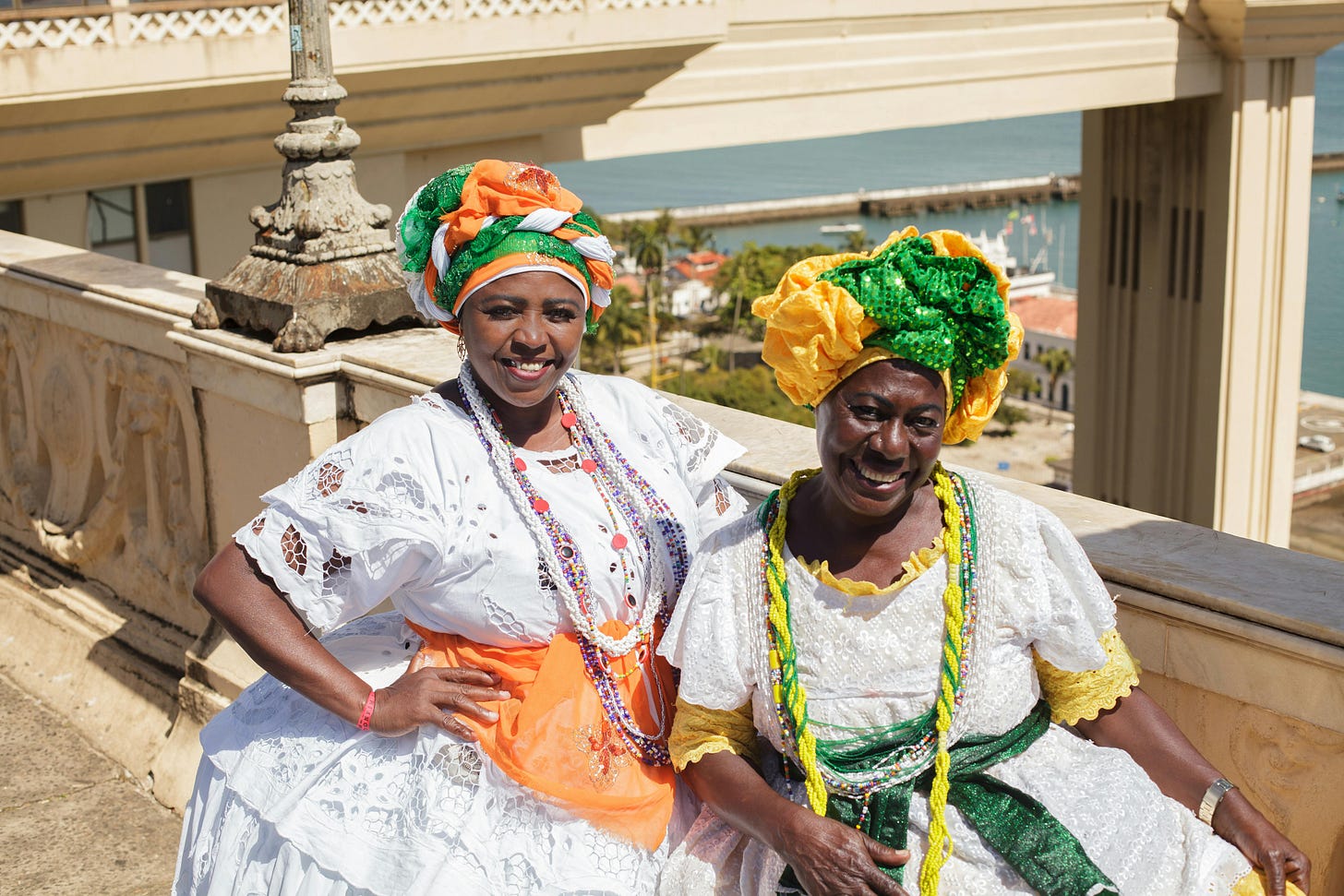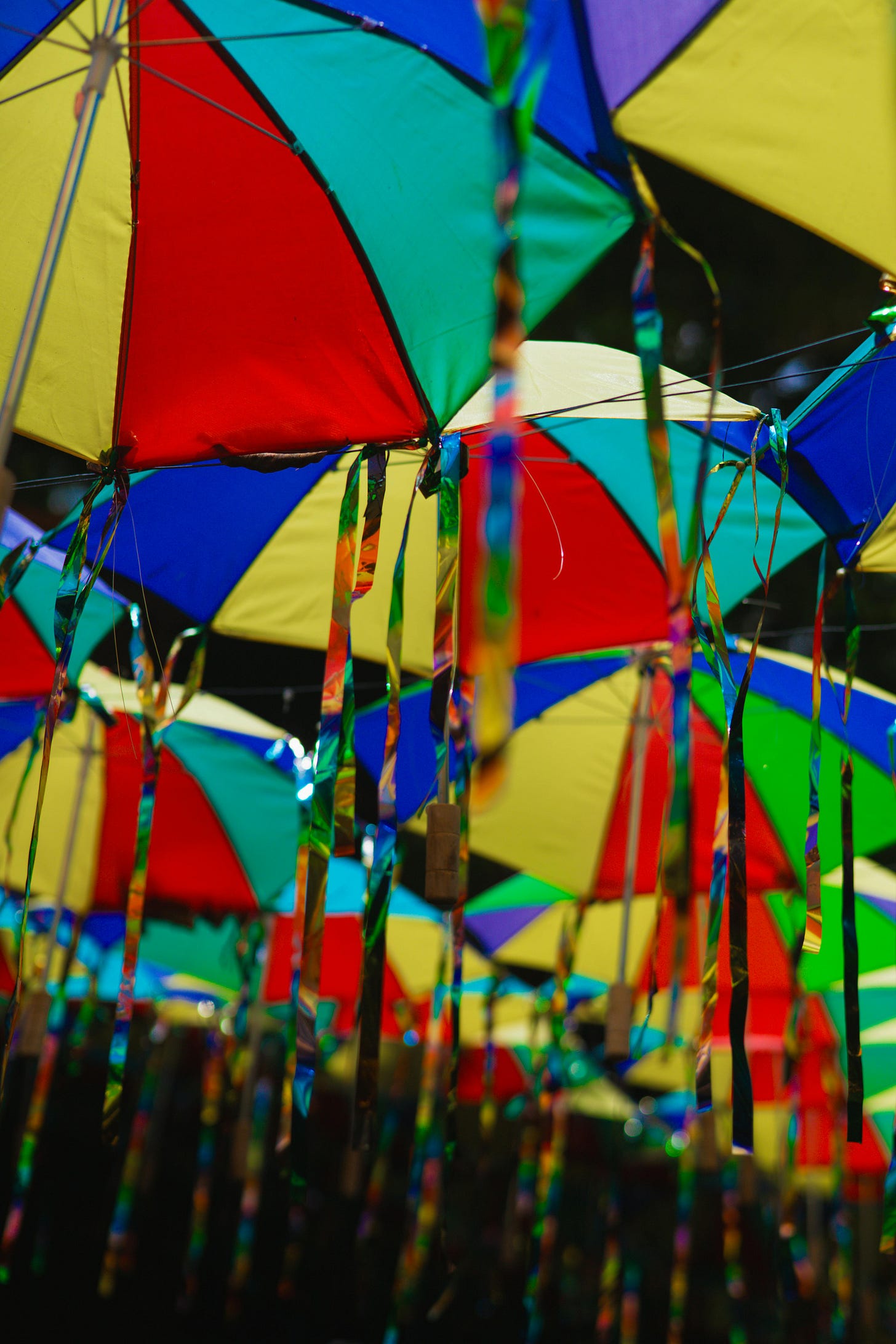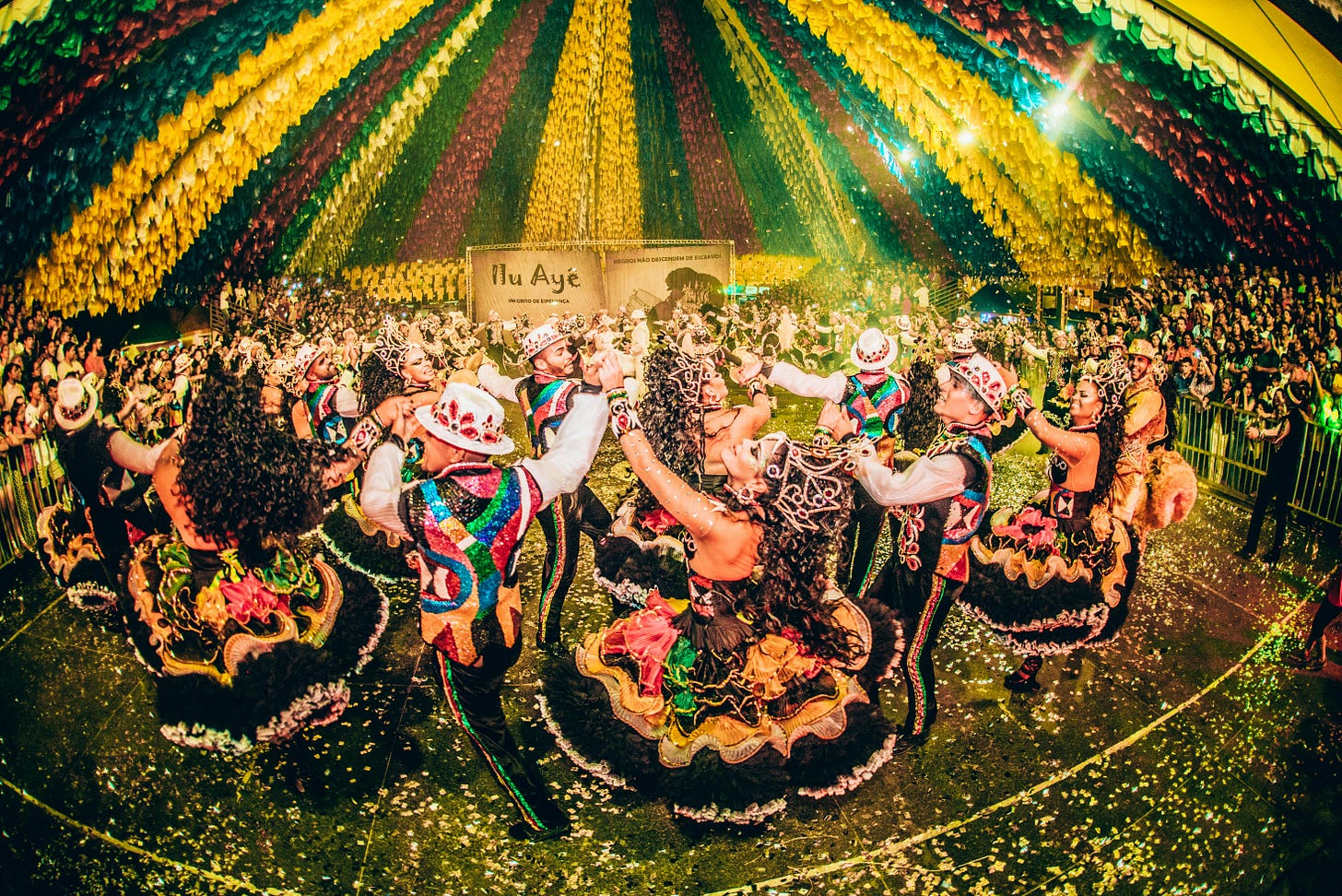Brazilian Carnival Explained: History, Samba Schools, and Must-Know Traditions
What Expats Need to Know About Brazilian Carnival
To begin with, I'm NOT a big fan of Carnival. When I was little, it was an obligation. We were members of a sports club, and every day of carnival there were matinees where the music played loudly, and we went to the dance in costumes. My mother would paint me and my sister with bright colors and glitter, and we just felt lost for about 4 hours. It was not fun.
Only when I was 18 did I truly enjoy Carnival. I worked at Embraer, and several friends who lived in Caçapava decided to create our own "bloco" (street party group), which we called "Pintores" (Painters). About 30 of us, all dressed alike (my mother, who was a seamstress, had to make all the costumes – poor thing! – we were of all sizes and shapes, and making everyone look the same was a Herculean feat). But this time, among friends, I was able to have fun and laugh all night until about 6 am, when we all went for breakfast, sweaty but happy, much to the chagrin of the Padoca (bakery) owner.
To this day, that's my best Carnival memory because it was just a backdrop for something bigger: a group of people who liked each other and mostly worked together. It was a real party.
After that, I experienced Carnival in Bahia, Rio, and Recife. But they say The Parintins Folklore Festival held annually in Parintins (Amazonas) is probably the most spectacular celebration centered around the Boi-Bumbá a folkloric legend about the death and resurrection of an ox and his story is the foundation for the entire event where there is a competition between two main groups:
Garantido: Represented by a red ox with a white heart.
Caprichoso: Represented by a blue ox with a star.
These two groups engage in elaborate performances, each trying to outdo the other with their displays of music, dance, costumes, and floats. Whomever tells the best story, wins. However, that's perhaps an idea for another post and one I still want to experience to better tell the story.
Still, I feel compelled to translate a bit of what Brazilian Carnival is for expats. Carnival’s origins are as layered as the costumes on display. While it’s tempting to think of Carnival as purely a celebration, its evolution is intertwined with centuries of history:
European Traditions & African Rhythms: Initially stemming from Catholic pre-Lenten festivities, Carnival in Brazil morphed as African slaves and indigenous cultures interwove their own traditions into the fabric of these celebrations. The result? A riot of music, dance, and storytelling that feels both ancient and fiercely modern.
Cultural Rebellion & Renewal: Beyond its religious and historical roots, Carnival became a space for social commentary. The parades tell stories of struggle, joy, resistance, and renewal—reminding us that every beat in the drum echoes a tale of survival and hope.
Spotlight on the Stars: Salvador, Recife, Rio and yes São Paulo
Salvador: Afro-Brazilian Soul
Salvador’s Carnival is a powerful display of Afro-Brazilian heritage. Its streets are alive with the beats of axé and samba-reggae, where every performance is an homage to cultural roots and resilience.
Rhythms & Movements: The music here isn’t just background noise—it’s a pulsating narrative that connects the community to its ancestors. The dance moves reflect stories of struggle, survival, and the vibrant spirit of Afro-Brazilian identity.
Recife and Olinda: A Carnival of Contrasts
Recife and its sister city Olinda, offers a carnival that is as diverse as it is dynamic. With a mix of Frevo and Maracatu (beautiful dances you’d have to be there to see). Its celebrations are a vibrant canvas painted with historical significance and contemporary flair.
Cultural Syncretism: Here, the carnival is a melting pot of influences, where traditional folklore meets modern performance art. Each rhythm and step is a dialogue between the past and the present, inviting onlookers to decipher its layers.
Rio de Janeiro: The Global Icon
Rio’s Carnival is a sensory overload in the best possible way. Here, the Escola de Samba (samba schools) transforms into storytelling stages where each parade is a narrative, crafted with passion and precision.
The Birth of a Samba School
Most samba schools were born in the favelas as a way for marginalized communities to reclaim their voice. Over decades, these groups have morphed into organized entities that plan year-round, not just for a one-night spectacle. They channel local stories, social issues, and dreams into a mesmerizing performance art that is both a party and a political statement. In many ways, these schools are like community startups that blend artistic flair with grassroots activism—each school has its unique story of resilience and hope.
Anatomy of a Samba School
Every element of a samba school is meticulously curated to tell a layered story:
Alas (Wings): Think of the alas as chapters in a living, breathing novel. Each section represents a different part of the school’s narrative—from historical events and folklore to contemporary social issues. These groups aren’t randomly assigned; they’re assembled based on passion, expertise, and the desire to honor a particular piece of the community’s heritage.
Porta Bandeira (Flag Bearer): More than a mere flag carrier, the porta bandeira is the embodiment of the school's spirit and legacy. Chosen for their poise, grace, and symbolic resonance, this role is a high honor. The flag they carry isn’t just fabric—it’s a banner of pride, a call to collective memory, and often, a tribute to cultural icons and ancestral traditions.
Mestre-Sala (Master of Ceremonies): Standing alongside the porta bandeira, the mestre-sala is responsible for the ceremonial dance that showcases the relationship between the flag bearer and the school’s heritage. Their interaction is a choreographed dialogue of respect, balance, and pride that has been passed down through generations.
Bateria (Drum Corps): This is the heartbeat of Carnival. The bateria isn’t simply a band; it’s a communal ritual. Months of rigorous rehearsals forge a unity of rhythm that synchronizes the entire parade. Every drumbeat is a pulse echoing the struggles, triumphs, and enduring spirit of the community.
Costume and Float Designers: Behind every vibrant costume and elaborate float is a team of artisans and storytellers. They transform ideas into visual spectacles, often working for months on designs that are as much about art as they are about symbolism. Each sequin and feather is chosen with a purpose, adding layers to the narrative that unfolds on the streets.
The Cultural and Social Impact
· The Escolas de Samba provide a creative outlet and a sense of belonging that extends far beyond the parade. For many, being part of a samba school means participating in a family that nurtures local talent, preserves cultural traditions, and even offers social support in times of need.
· This community-driven model also serves as a powerful educational platform—teaching younger generations about history, art, and the importance of unity. It’s not just about making a spectacle; it’s about making a statement which carries the weight of generations of struggle and the hope for a better future.
· In essence, the Escolas de Samba are a testament to the power of storytelling through art. They prove that behind every dazzling parade lies a profound story of identity, struggle, and above all, hope—a story that invites everyone to dance, reflect, and celebrate life in all its messy, beautiful glory.
Lastly, beyond the Parades we now have the Carnaval de Rua de São Paulo
While Rio, Salvador, and Recife might steal the limelight, São Paulo’s street Carnival is a phenomenon worth noting. In recent years, the growth of Carnaval de Rua de São Paulo has been driven by a mix of factors:
Urban Infrastructure & Demand: With other cities struggling to offer the same scale and diversity of street festivities, São Paulo has stepped up to fill the void. The city’s sprawling urban environment provides a perfect stage for impromptu performances and large-scale gatherings.
Community & Inclusivity: This isn’t just a party—it’s a grassroots movement that brings people together in the urban landscape. Yet, as exhilarating as it is, the sheer volume of people can sometimes mean compromised safety and overcrowding, issues that every potential visitor should weigh before diving in.
Carnival for Expats: A Must-Experience (with a good level of Caution)
If you’re an expat contemplating your first Carnival, here’s the no-sugar-coating truth:
Experience Once, Reflect Forever: Carnival is a kaleidoscope of culture and emotion. It’s not just about the glitz and glamour, but about understanding the stories, the struggles, and the triumphs that these celebrations represent. Even if you’re not a die-hard fan, experiencing Carnival at least once can offer insights into a culture that thrives on expression and resilience.
Safety First: Let’s be honest—Carnival can be overwhelming. The massive crowds, the contagious energy, and yes, the occasional lapses in safety, make it a thrilling but potentially unpleasant adventure. Plan ahead, stick to well-known routes, and always keep an eye on your belongings, especially cell phones and cameras.
In the end, Carnival is a masterclass in human expression. It teaches us that behind every flamboyant costume and every thundering drumbeat lies a deep history and a profound story of a people determined to celebrate life in all its messy, vibrant glory. Whether you’re drawn by the pulsating energy of Rio, the soulful beats of Salvador, or the eclectic charm of Recife, embracing Carnival means opening your mind to a world where every rhythm tells a story.
So, even if you’re more of a “sit back and watch” kind of expat, consider this your call to experience Carnival at least once. Just be smart, be safe, and let the rhythm move you—just don’t lose your wallet in the process!
And as usual:
If you found this deep dive into Carnival fascinating, we’ve got even more for you! 🎭✨ We’ve put together an exclusive eBook covering everything from the origins of Brazil’s greatest Carnivals to the hidden meanings behind every beat, costume, and dance move. Want a copy? Just DM us, and we’ll send it your way! 📩
And if you have your own Carnival story—whether it’s a mind-blowing parade experience, a funny mishap, or a hidden gem you discovered—we’d love to hear it! Drop a comment or message us and let’s keep the conversation going. 🎉🔥





